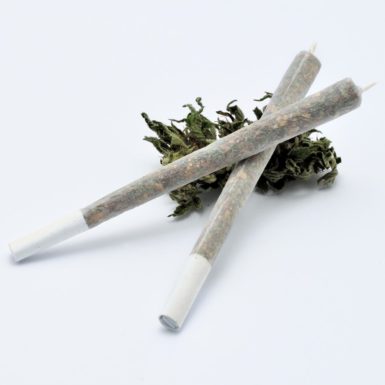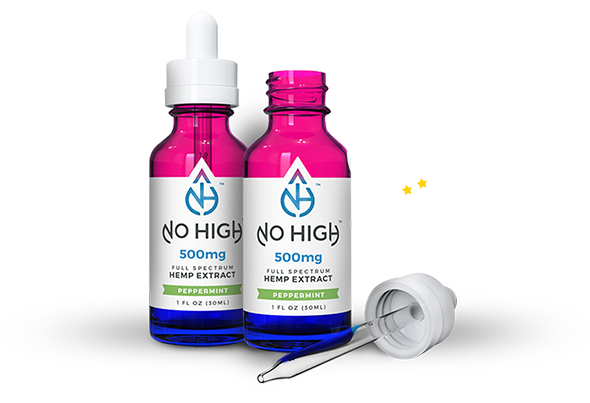CBG stands for Cannabigerol. CBG is a phytocannabinoid present in the Cannabis plant. CBG is a precursor of other cannabinoids like tetrahydrocannabinol (THC), cannabidiol (CBD), and cannabichromene (CBC). Because CBD is a precursor, it is generally low in concentration in cannabis plant matter.3
Like CBD, CBG may have anti-inflammatory and analgesic properties due to its ability to inhibit the production of proinflammatory compound prostaglandin.3 CBG possesses antiproliferative effects that may support cancer therapy. CBG has also demonstrated the ability to and inhibit dopamine, norepinephrine, GABA, and serotonin reuptake which suggest it may have benefits for neuropsychiatric disorders like depression. CBG benefits may also include skin conditions, glaucoma, sex hormonal dysregulations, eating disorders, and bone healing.
What is CBG (Cannabigerol)?
The therapeutic use of cannabis has been limited by the major psychoactive constituent THC. New attention focusing on hemp and non-psychoactive cannabinoids like cannabidiol (CBD), cannabichromene (CBC), and cannabigerol (CBG) to explore ways to get the benefits of cannabis without the high.
Like THC and CBD, CBG has a wide spectrum of known and purported benefits. CBG also has amazing potential as a starting molecular structure for developing more selective or more potent drugs.3 Among all of its benefits, CBG’s anti-inflammatory and anticancer properties suggest it may be used to develop novel drugs to address conditions where pathological inflammatory responses and abnormal cell proliferation lead to diseases and disorders.
How to Use CBG
CBG Flower Strains

Hemp breeders are developing new strains that retain high levels of CBG. Normally, CBG is not present in large concentrations in harvested hemp flower. CBG pre-rolls and CBG extracts are made using CBG flower strains. Normal full-spectrum CBD products may contain small amounts of CBG. CBG isolate products are more useful than full-spectrum CBD tinctures for getting a significant amount of CBG.
CBG Isolate
CBG interacts with both the CB1 and CB2 receptors which makes it a valuable cannabinoid. CBG flower strains are not yet widely cultivated. Extraction and cannabinoid separation are currently the main ways to get CBG isolate. 99% pure CBG isolate powder is used to make CBG isolate products. This allows manufacturers to formulate concentrated CBG products.
CBG vs. CBD – What is the Difference?
CBG can be thought of as undifferentiated CBD. Like CBD, CBG is not psychoactive and won’t get you high. The acidic form of CBG is CBGA. It is the first cannabinoid cannabis plants develop. Enzymes convert CBG into CBD or THC as hemp plants develop.


The History of CBG
Due to its difficult availability, CBG has received little attention in research until recently. CBG concentrations in the cannabis plant are usually extremely low (about 10%) due to its rapid conversion into tetrahydrocannabinol (THC), cannabidiol (CBD), and cannabichromene (CBC).3
Genetic engineering is now allowing the generation of CBG-predominant cannabis plants.3 These plants carry a recessive gene allele which reduces the ability of enzymes to convert CBG into THC, CBD, and CBC. CBG-predominant cannabis contains a higher CBG concentration of up to 94% of the cannabinoid extract fraction.
Since researchers are now able to access more CBG we can begin to learn more about the cannabinoid. This means that there is still a lot of research to be done to confirm claims about how CBG may work and what benefits or harms CBG may have for humans.
How Does CBG Work?
Human CBG bioavailability is still unknown, but its pharmacokinetics in rodents has been reported from research.3 Plasma and brain pharmacokinetics of CBG (120 mg/kg, oral and intraperitoneal) were studied in rats and mice. Researchers found:
- CBG readily crossed the blood-brain barrier (BBB)3
- CBG has the ability to produce G-protein-coupled-receptor activation or blockade3
- CBG demonstrated partial agonism/antagonism at cannabinoid type-1 (CB-1) and type-2 (CB-2) receptors6
- CBG has been demonstrated to act as an agonist for α2-adrenoceptors, but receptor subtypes selectivity awaits further elucidation3
Likewise, CBG acts on several enzymes involved in pathways that influence inflammation, mood, and cell damage. CBG can influence the activity of compounds like dopamine, and several inflammatory factors.
CBG Receptor Targets
- Serotoninergic Receptors
- Cannabinoid Receptors
- Peroxisome Proliferator-Activated Receptors
- α2-Adrenoceptors
- Vanilloid Receptors
- Melastatin
- Ankyrin Channels
CBG Modulated Enzymes Activity
- Monoacylglycerol lipase (MAGL)
- Nacylethanolamine acid amide (NAAA) hydrolase
- Cyclooxygenase (COX)
- Phospholipase-A2 (PLA2)
- Prostaglandin-E2 production (PGE2)
CBG Benefits and Effects
The abstract for Roger Pertwee’s patent for “Therapeutic uses of cannabigerol (US20100292345A1)” claims that CBG could be of benefit to almost every major disease and disorder.
“The present invention relates to the use of the cannabinoid cannabigerol (CBG) in the manufacture of medicaments for use in the treatment of diseases and conditions benefiting from concurrent agonism of the CBi and the CB2 cannabinoid receptors. Such diseases or conditions to be treated are taken from the group: pain, neurodegenerative disease, ischemic disease, brain injury or damage, acquired brain injury, age related inflammatory or autoimmune disease, cachexia, nausea and vomiting, glaucoma, movement disorders, rheumatoid arthritis, asthma, allergy, psoriasis, Crohn’s disease, systemic lupus erythematosus, diabetes, cancer, osteoporosis, renal ischemia and nephritis.”
We dug into the most recent published research to see if CBG is proving to live up to the lofty potential set out by Pertwee.
Anti-inflammation and Analgesia
There is growing evidence that many cannabinoids may reduce sensitivity to pain by acting as analgesics. Non-steroidal anti-inflammatory drugs (NSAIDs) act largely through inhibition of cyclooxygenases (COXs) to treat pain and inflammation.3 How do these biochemical cascades work to reduce pain and inflammation?
COXs induce arachidonic acid to convert into prostaglandins.3 Prostagladins are hormone-like lipids responsible for homeostatic regulation of mechanisms like inflammatory responses.
CBG may prevent inflammation by affecting the production of prostaglandins, by inhibiting the production of the prostaglandin PGE2, or by inhibiting COXs.3 Data from experiments have suggested that CBG is more potent but less maximally effective than THC and aspirin in a test of anti-inflammatory potential (phenyl benzoquinone (PBQ) model of peripheral inflammatory pain). In a behavioral model of inflammatory pain, CBG dose-dependently reduced the first and second pain-feeling phases associated with pain sensation mediated by α2-adrenoceptors.
Neuroinflammation in Multiple Sclerosis
Neuroinflammation is a component of disorders, such as multiple sclerosis (MS), Alzheimer and Parkinson’s diseases and can occur in response to traumatic brain injury, infections, aging, toxic metabolites, or autoimmunity issues.4 Acute and chronic neuroinflammation have slightly different reactions in the brain. Chronic neuroinflammation can lead to neuro-degradation.
Acute Neuroinflammation
- Rapid activation of microglia
- No peripheral immune response
Chronic Inflammation
- Microglia induce sustained production of inflammatory modulators
- May result in an alteration to the integrity of the blood-brain barrier (BBB)
- May recruit peripheral immune cells for inflammatory responses
- Ultimately leads to neuronal dysfunction/neurodegeneration
Multiple sclerosis is a chronic inflammatory demyelinating disease where microglial activation contributes to the pathology by secreting pro-inflammatory mediators.4 Researchers have studied the disorder using CBG and its quinone flavanoid derivates called VCE-003. In mouse models of MS, CBG derivatives improved functioning. CBG andnVCE-003 revealed neuroprotective action and VCE-003 improved motor functions and locomotor activity. An autoimmune model of MS VCE-003 decreased microglial activation resulting in structural protection of myelin sheets and reduced axonal nerve damage.
Neuroprotective Effects
Inflammation and oxidative stress play main roles in neurodegeneration.5 Many natural compounds may be able to exert neuroprotective actions against inflammation and oxidative stress. Natural compounds like cannabinoids can do this by protecting from neuronal cell loss. To demonstrate the potential of CBG to help cells resist damage from neuroinflammation and oxidative stress, researchers pre-treated cells with CBG. The CBG pre-treated cells counteracted inflammation by reducing levels of IL-1β, TNF-α, IFN-γ and PPARγ proteins that lead to inflammation. These cells also resisted damage from oxidative stress, demonstrating the potential of CBG to protect cells from neurodegeneration.
Parkinson’s Disease
Parkinson’s disease is a progressive central nervous system disorder. Researchers have studied the disorder in mouse models using CBG and its quinone flavanoid derivates called VCE-003.2.4 Neuroprotection in Parkinson’s disease (PD) has been observed through the antioxidant and anti-inflammatory properties of cannabinoids.
VCE-003.2 has activity at the peroxisome proliferator-activated receptor-γ (PPARγ) and is also an antioxidant.4 VCE-003.2 has no activity at the cannabinoid receptors but has neuroprotective action against inflammation-driven neuronal damage in Parkinson’s disease models of neuroinflammation.
Appetite Stimulant
A study on CBG’s effects on rat feeding behavior revealed it was not effective in doses up to 17.6mg/kg.3 Further research revealed that higher doses of CBG like 120mg/kg and 240mg/kg induced a dose-dependent increase in food intake, number of meals, a decrease of latency to first meal and an enhanced locomotor activity.1, 2 Those findings suggest that at higher doses CBG stimulates appetite and feeding behavior.
A dosage of 120mg/kg pure CBG is being explored as a way to attenuate weight loss induced by the chemotherapy agent cisplatin.1, 2 Given the promise of these early findings, CBG is being suggested by some for feeding disorders associated with chemotherapy and the treatment of weight loss in cancer anorexia-cachexia syndrome.
Bladder Problems
Anecdotal accounts suggest that CBG, THCV, and CBD may help bladder dysfunctions.7 One small study observed that CBG especially reduced acetylcholine-induced contractions in the human bladder. The study noted that acetylcholine-induced contractions were not affected by CB-1 or CB-2 receptor antagonists, but more work is needed to determine how CBG helps bladder problems and if it can significantly improve symptoms of bladder dysfunctions.
Inflammatory Bowel Diseases
Inflammatory bowel disease (IBD) describes a group of inflammatory conditions of the colon and intestine.3 Dysregulated immune responses cause inflammatory conditions like these. IBDs include ulcerative colitis limited to the colon and Crohn disease.
Effects of CBG on TRP Channel-Mediated Intestinal Inflammation
TRP channels play a role in gastrointestinal inflammation by sensing if a physical or chemical stimulus is innocuous or noxious (harmful/irritating).3 TRP channels are also involved in the anti-inflammatory effects of phytocannabinoids. This leads researchers to believe cannabinoids like CBG may be able to help the body regulate TRP channels better. If this were the case, CBG could help reduce symptoms of IBDs.
- CBG exerted significant elevation of intracellular Ca++ via TRPV3-mediated channels
- When administered 5 min earlier, CBG also desensitized TRPV3 to carvacrol-mediated cell stimulation
- CBG induced a significant TRPV4-mediated elevation of intracellular Ca++ with low efficacy and medium-low potency
- Despite its low efficacy, CBG desensitized TRPV4 to the action of its agonist 4αPDD
- CBG desensitizes TRPV to endogenous stimuli and at doses lower than required to activate them
- CBG may be useful as a TRPV desensitizer
Effects of CBG on Colitis Inflammation Pathways
In a (DNBS) mouse model of colitis, CBG showed protective and curative effects by reducing colon weight to length ratio (an indicator of inflammatory severity).3 CBG reduced DNBS-induced overexpression of the inducible nitric oxide synthase (iNOS), but not of COX-2. In lipopolysaccharide-activated macrophages, DNBS induces an increase in colonic inflammatory factors interleukin-1β and interferon-γ, and a decrease in interleukin-10 levels. CBG has demonstrated an ability to counteract these alterations.
- Nitric oxide production and iNOS protein overexpression may be inhibited by CBG
- CBG restored the DNBS-induced decrease of superoxide-dismutases
- Through these actions, CBG restored antioxidant protection in intestinal epithelial cells
Mood Disorders
The endocannabinoid system (ECS) has a bidirectional influence on anxiety3:
- ECS inhibition results in anxiogenic (anxiety generating) responses
- Moderate increase to ECS stimulation leads to anxiolytic (anti-anxiety) effects
The natural endocannabinoid anandamide also has a bidirectional profile3:
- Anxiolytic agent at CB1R
- Anxiogenic at TRPV1
CBG research is showing that it does not perform well in models of anxiety, but does perform well on models of depression.3 These findings are of special interest because depression and anxiety often occur together. CBD, which has shown strong anxiolytic effects naturally occurs with CBG, hinting that a full spectrum hemp extract could be especially helpful in those conditions.
Cancer
Cannabinoids are used in the treatment of nausea and vomiting associated with chemotherapy. Cannabinoids inhibit the growth of various cancer cell types by inducing apoptosis, cell-cycle arrest, cell growth inhibition, affecting angiogenesis, and cell migration.3
CBG Anti-Cancer Properties
- Reduce cell proliferation in several cancer cell lines like human breast, prostate, colorectal carcinoma, and more
- Only CBD and CBG elicited antiproliferative effects in prostate carcinoma cells
- CBG-sensitive channels TRPV1, TRPV2, and TRPM8 are involved in prostate cancer
- TRPV1 agonist capsaicin induces antiproliferative and pro-apoptotic effects on prostate cancer cells
- TRPV2 activation stimulates prostate cancer cell migration
- TRPM8 is overexpressed in androgen-dependent prostate cancer cell
- CBG antagonizes TRPM8 channels and activates/desensitize TRPV2 and TRPV1 leading to prostate cancer suppression
- Prostate cancer cell viability was inhibited by CBG in androgen receptor-positive and receptors-negative prostate cancer cell lines
- CBG can slow prostate cancer cell proliferation and induce apoptosis (programmed cell death)
- Cancer growth activity most in human oral epitheloid carcinoma cell lines may be inhibited by CBG
- CBG is not the most potent anti-cancer phytocannabinoid, but it has demonstrated antiproliferative action in human breast cancer cells and mouse skin melanoma cells
Other Uses for CBG
In animal research, CBG was found to inhibit testosterone synthesis. In males, this activity may help regulate symptoms of prostate cancer and hypersexuality. Testosterone lowering medications are also used in male contraception and gender reassignment. CBG has the potential to be used as a natural testosterone lowering substance.
For women, inhibiting testosterone production can also be beneficial. Medications that lower testosterone production are often used to treat severe cases of acne, amenorrhea, seborrhea, hirsutism, androgenic alopecia, and hyperandrogenism.
CBG’s testosterone inhibiting action provides many benefits to the skin.3 CBG works through another pathway to inhibit cells that cause psoriasis. Through yet another mechanism CBG can also work to stimulate stem cells and encourage regenerative healing of the bones and body. Lastly, CBG potently inhibits methicillin-resistant Staphylococcus aureus (MRSA) and has amazing antibiotic potential.
Final Thoughts on CBG (Cannabigerol)
While recent research findings highlight vast potentials for CBG extensive work is needed before its benefits can be definitively stated. CBG pharmacokinetics and pharmacodynamics in humans are still unknown, and CBG users should be cautious until more definite studies demonstrate the safety and efficacy of CBG.
CBG: Where You Can Buy It?
[Chart of CBG products coming soon!]
Common Questions About CBG
What does CBG mean?
Cannabigerol (CBG) is one of over 120 identified cannabinoids found in cannabis plants. Cannabigerol is the non-acidic form of cannabigerolic acid. CBG the parent molecule from which other cannabinoids are synthesized.
What does CBG do?
CBG can bind to CB-1 and CB-2 receptors in the endocannabinoid system. It is thought to have several health benefits for symptoms of mood disorders, inflammation, and cancer.
Where to buy CBG?
CBG products can be purchased online. Look for our full-spectrum CBD products today!
References
- Brierley, D. I., Samuels, J., Duncan, M., Whalley, B. J., & Williams, C. M. (2016). Cannabigerol is a novel, well-tolerated appetite stimulant in pre-satiated rats. Psychopharmacology, 233(19-20), 3603–3613. doi:10.1007/s00213-016-4397-4. Retrieved from: https://link.springer.com/article/10.1007/s00213-016-4397-4
- Brierley, D. I., Samuels, J., Duncan, M., Whalley, B. J., & Williams, C. M. (2017). A cannabigerol-rich Cannabis sativa extract, devoid of [INCREMENT] 9-tetrahydrocannabinol, elicits hyperphagia in rats. Behavioural pharmacology, 28(4), 280-284. Retrieved from: https://discovery.ucl.ac.uk/10048069/1/Brierley_Cannabigerol-rich_Cannabis.pdf
- Deiana, S. (2017). Potential Medical Uses of Cannabigerol: A Brief Overview. In Handbook of Cannabis and Related Pathologies (pp. 958-967). Academic Press. Retrieved from: https://www.sciencedirect.com/science/article/pii/B9780128007563001150
- García, C., Gómez-Cañas, M., Burgaz, S., Palomares, B., Gómez-Gálvez, Y., Palomo-Garo, C., … Fernández-Ruiz, J. (2018). Benefits of VCE-003.2, a cannabigerol quinone derivative, against inflammation-driven neuronal deterioration in experimental Parkinson’s disease: possible involvement of different binding sites at the PPARγ receptor. Journal of neuroinflammation, 15(1), 19. doi:10.1186/s12974-018-1060-5. Retrieved from: https://link.springer.com/article/10.1186/s12974-018-1060-5
- Gugliandolo, A., Pollastro, F., Grassi, G., Bramanti, P., & Mazzon, E. (2018). In Vitro Model of Neuroinflammation: Efficacy of Cannabigerol, a Non-Psychoactive Cannabinoid. International journal of molecular sciences, 19(7), 1992. doi:10.3390/ijms19071992. Retrieved from: https://www.mdpi.com/1422-0067/19/7/1992/htm
- Navarro, G., Varani, K., Reyes-Resina, I., Sánchez de Medina, V., Rivas-Santisteban, R., Sánchez-Carnerero Callado, C., … Franco, R. (2018). Cannabigerol Action at Cannabinoid CB1 and CB2 Receptors and at CB1-CB2Heteroreceptor Complexes. Frontiers in pharmacology, 9, 632. doi:10.3389/fphar.2018.00632. Retrieved from: https://www.frontiersin.org/articles/10.3389/fphar.2018.00632/full
- Pagano, E., Montanaro, V., di Girolamo, A., Pistone, A., Altieri, V., Zjawiony, J. K., … & Capasso, R. (2015). Effect of non-psychotropic plant-derived cannabinoids on bladder contractility: focus on cannabigerol. Natural product communications, 10(6), 1934578X1501000653. Retrieved from: https://journals.sagepub.com/doi/pdf/10.1177/1934578X1501000653
- Pertwee, R. (2010). Therapeutic uses of cannabigerol. U.S. Patent Application No. 12/666,385. Retrieved from: https://patentimages.storage.googleapis.com/63/3c/24/5b12ed048caab0/US20100292345A1.pdf
